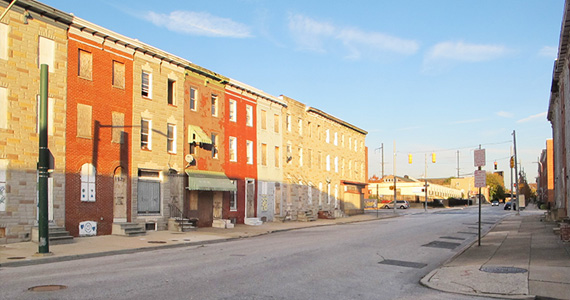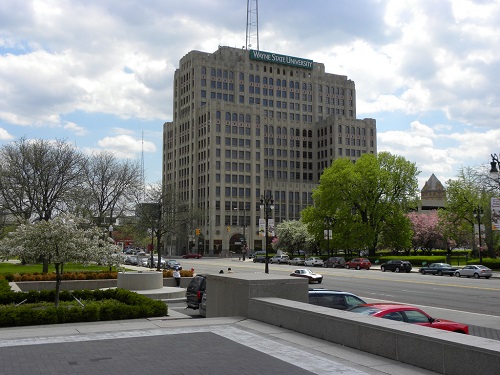
Anchoring Inclusive Economic and Community Development

A typical street in an East Baltimore neighborhood. As hospitals, universities, and other institutions assume increased significance in the postindustrial economy, many of these anchor institutions are adopting more active roles in initiatives that support social equity and economic inclusion. Especially in older Rust Belt cities, anchors can serve as catalysts for sustainable, smart growth, advancing strategies that cut across the social, economic, and physical dimensions of neighborhoods.
Earlier this year, anchor institution partners from Detroit and Baltimore joined planners, policymakers, and community developers in Denver at a conference called “New Partners for Smart Growth: Building Safe, Healthy, Equitable, and Prosperous Communities.” The participants discussed strategies anchors are using to better align their needs and interests with the needs of their local communities.
Economic Inclusion Efforts in Detroit and Baltimore
In Detroit, a coalition of philanthropic, public, and private partners have aligned their efforts to develop an anchor strategy for the city’s Midtown area. Located north of downtown Detroit, Midtown is home to Wayne State University, Detroit Medical Center, and the Henry Ford Health System. These three institutions employ approximately 28,000 people, representing tremendous economic potential for both the surrounding neighborhood and the city as a whole.
In recent years, the organizations have embraced an active role in programs and initiatives aimed at improving neighborhood residents’ quality of life. Sue Mosey, president of Midtown Detroit Incorporated (MDI), discussed how the anchor strategy in Detroit has evolved from passive partnerships into an explicit set of strategies that support neighborhoods in several ways.

Wayne State University is one of the active partners in the revitalization of the Midtown area of Detroit. Image courtesy of Jason Paris, used under Creative Commons.
Through Live Midtown, the three anchors are encouraging more of their employees to become neighborhood residents. Aimed at new and existing residents, the program offers employees financial incentives to purchase and rent homes in the neighborhood. Live Midtown is part of an active effort to increase the neighborhood’s population, which currently stands at approximately 22,000 residents. Mosey noted that, to date, nearly 800 employees have participated and the program has been successful in reaching large numbers of African American, Asian, and white residents. Mosey characterized Live Midtown as a “win-win” option that provides residents with a meaningful incentive to live in the neighborhood while helping the anchors attract and retain employees.
The anchors are also engaging in strategic efforts to promote economic development opportunities in the Midtown area and across the city. Together, the three institutions have shifted a portion of their procurement contracts to Detroit- and local-area businesses. Although this strategy is relatively new and represents only a fraction of the anchors’ purchasing power, it has created new community business opportunities and strengthened the vitality of existing businesses across the city. Efforts to expand economic opportunity have also included programs to match local residents with local jobs. Henry Ford Health System has partnered with a workforce development organization to help area residents secure jobs at the hospital. The program has shown early signs of success, and Mosey noted that its long-term success would be based at least in part on its ability to match the hospital’s human resource needs with the career pathways the workforce development organization seeks for its clients.
The city of Baltimore faces many of the same challenges as Detroit, and organizations and institutions in the city have responded with strategies aimed at supporting inclusive economic development. Scot Spencer, associate director for advocacy and influence with the Annie E. Casey Foundation, discussed the East Baltimore Revitalization Initiative, which is improving access to economic opportunities for low-income, minority residents of the city’s East Baltimore neighborhood.
Located adjacent to Johns Hopkins University, East Baltimore is in the midst of a dramatic transformation that proponents hope will turn one of the city’s poorest neighborhoods into a mixed-income neighborhood and a catalyst for local economic growth. For Johns Hopkins, part of that growth strategy has included committing to local hiring and increasing opportunities for women- and minority-owned businesses to receive project-related contracts. Spencer discussed the economic reach of Johns Hopkins, through both direct hiring and indirect supply chain hiring, in highlighting the potential anchor institutions have to promote inclusive economic growth. Victor Rubin, vice president for research with PolicyLink and the moderator of the panel, noted that because anchor institutions create jobs requiring a range of skill and education levels, workforce planning strategies must be tailored to reach individuals of different abilities, skill sets, and educational attainment.
In many cities, anchor institutions are beginning to explicitly embrace their role as partners for inclusive development and catalysts for smart growth. The work being done in Baltimore and Detroit underscores the potential for aligning economic inclusion strategies into larger redevelopment efforts in urban neighborhoods.
PD&R Leadership Message Archive
International & Philanthropic Spotlight Archive
Spotlight on PD&R Data Archive
Publications
Collecting, Analyzing, and Publicizing Data on Housing Turnover
Resilience Planning: What Communities Can Do to Keep Hazards from Turning into Disasters
Cityscape: Volume 26, Number 3
Case Studies
Case Study: Former School in Charleston, South Carolina, Transformed into Affordable Housing for Seniors
Case Study: Avalon Villas Combines Affordable Housing and Services for Families in a Gentrifying Phoenix Neighborhood

The contents of this article are the views of the author(s) and do not necessarily reflect the views or policies of the U.S. Department of Housing and Urban Development or the U.S. Government.
Note: Guidance documents, except when based on statutory or regulatory authority or law, do not have the force and effect of law and are not meant to bind the public in any way. Guidance documents are intended only to provide clarity to the public regarding existing requirements under the law or agency policies.



